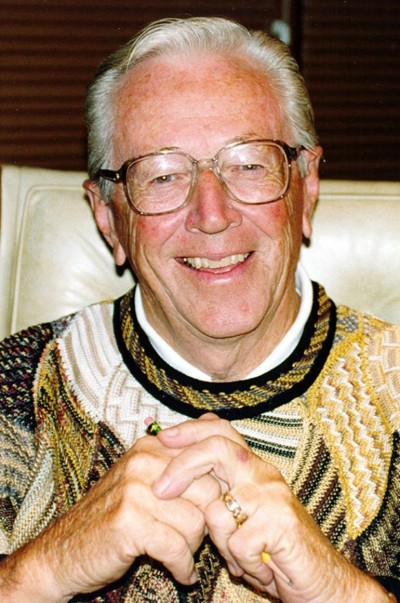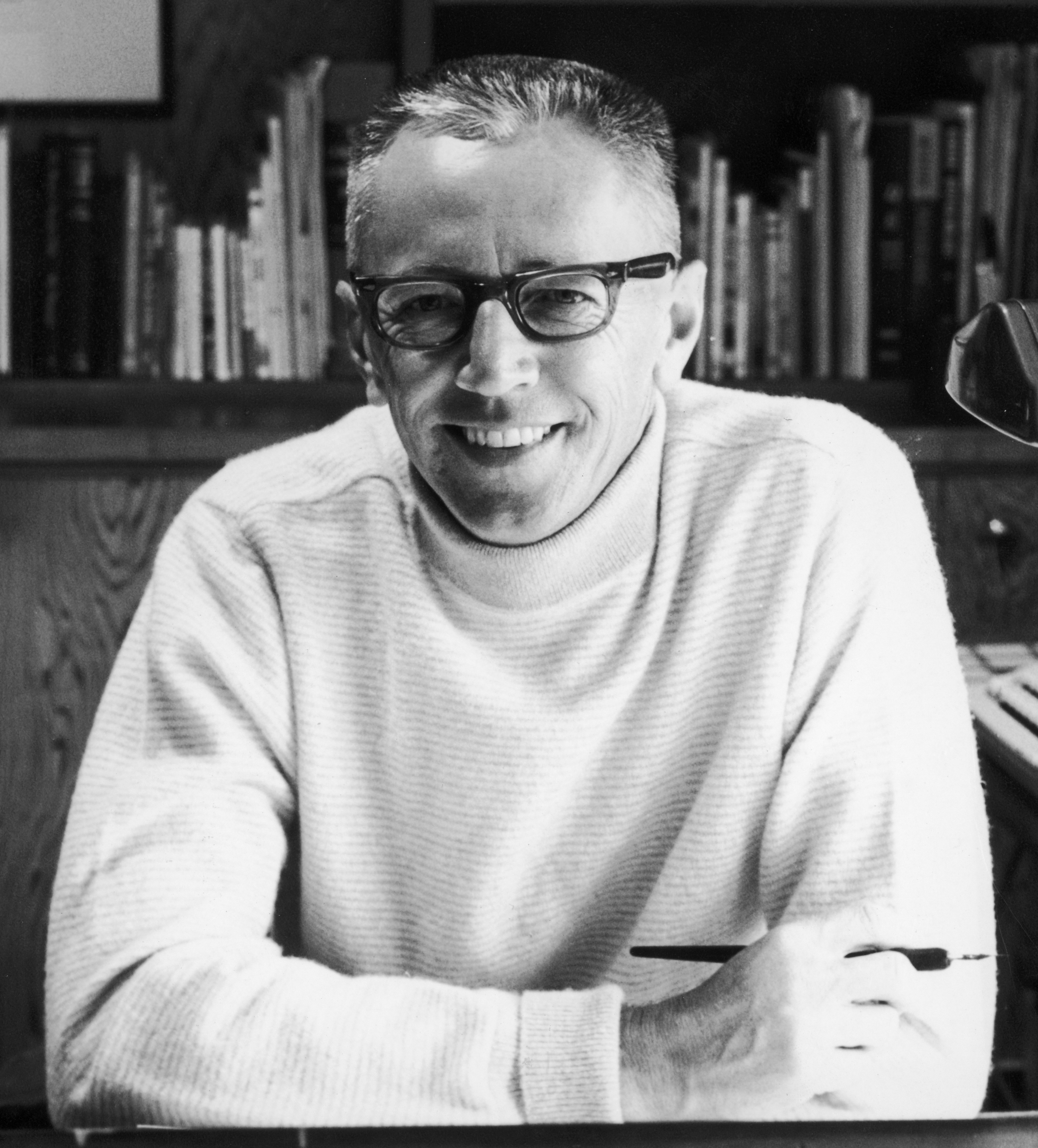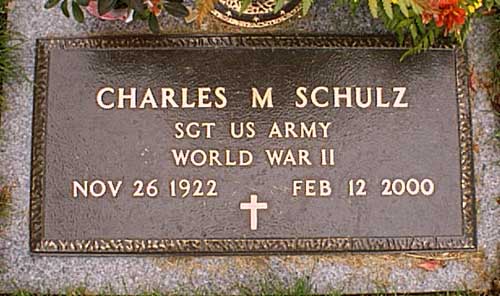Charles Schulz (Charles Monroe Schulz)

Born in Minneapolis, Minnesota, Schulz grew up in Saint Paul. He was the only child of Carl Schulz, who was born in Germany, and Dena Halverson, who was Norwegian. His uncle called him “Sparky” after the horse Spark Plug in Billy DeBeck’s comic strip, Barney Google. Schulz loved drawing and sometimes drew his family dog, Spike, who ate unusual things, such as pins and tacks. In 1937, Schulz drew a picture of Spike and sent it to Ripley’s Believe It or Not!; his drawing appeared in Robert Ripley’s syndicated panel, captioned, “A hunting dog that eats pins, tacks, and razor blades is owned by C. F. Schulz, St. Paul, Minn.” and “Drawn by ‘Sparky'” (C.F. was his father, Carl Fred Schulz). Schulz attended Richards Gordon Elementary School in Saint Paul, where he skipped two half-grades. He became a shy, timid teenager, perhaps as a result of being the youngest in his class at Central High School. One well-known episode in his high school life was the rejection of his drawings by his high school yearbook. A five-foot-tall statue of Snoopy was placed in the school’s main office 60 years later.
In February 1943, Schulz’s mother Dena died after a long illness. At the time of her death, he had only recently been made aware that she suffered from cancer. Schulz had by all accounts been very close to his mother and her death made a strong impact on him. Around the same time, Schulz was drafted into the United States Army. He served as a staff sergeant with the 20th Armored Division in Europe, as a squad leader on a .50 caliber machine gun team. His unit saw combat only at the very end of the war. Schulz said that he only ever had one opportunity to fire his machine gun but forgot to load it. Fortunately, he said, the German soldier he could have fired at willingly surrendered. Years later, Schulz proudly spoke of his wartime service. After being discharged in late 1945, Schulz returned to Minneapolis. He did lettering for a Roman Catholic comic magazine, Timeless Topix, and then, in July 1946, took a job at Art Instruction, Inc., reviewing and grading lessons submitted by students. Schulz himself had been a student of the school, taking a correspondence course from it before he was drafted. He worked at the school for a number of years while he developed his career as a comic creator, until he was making enough money from comics to be able to do that full-time.
Schulz’s first regular cartoons, a weekly series of one-panel jokes entitled Li’l Folks, were published from 1947 to 1950 by the St. Paul Pioneer Press; he first used the name Charlie Brown for a character there, although he applied the name in four gags to three different boys as well as one buried in sand. The series also had a dog that looked much like Snoopy. In 1948, Schulz sold a cartoon to The Saturday Evening Post; the first out of 17 one-panel cartoons by Schulz that would be published there. In 1948, he tried to have Li’l Folks syndicated through the Newspaper Enterprise Association. Schulz would have been an independent contractor for the syndicate, unheard of in the 1940s, but the deal fell through. Li’l Folks was dropped from the Pioneer Press in January 1950.
Later that year, Schulz approached the United Feature Syndicate with the one-panel series Li’l Folks, and the syndicate became interested. However, by that time Schulz had also developed a comic strip, using normally four panels rather than one, and reportedly to Schulz’s delight, the syndicate preferred this version. Peanuts made its first appearance on October 2, 1950, in seven newspapers. The weekly Sunday-page debuted on January 6, 1952. After a somewhat slow beginning, Peanuts eventually became one of the most popular comic strips of all time, as well as one of the most influential. Schulz also had a short-lived sports-oriented comic strip called It’s Only a Game (1957–1959), but he abandoned it due to the demands of the successful Peanuts. From 1956 to 1965 he contributed a single-panel strip (“Young Pillars”) featuring teenagers to Youth, a publication associated with the Church of God. In 1957 and 1961 he illustrated two volumes of Art Linkletter’s Kids Say the Darndest Things, and in 1964 a collection of letters, Dear President Johnson, by Bill Adler.
At its height, Peanuts was published daily in 2,600 papers in 75 countries, in 21 languages. Over the nearly 50 years that Peanuts was published, Schulz drew nearly 18,000 strips. The strips themselves, plus merchandise and product endorsements, produced revenues of more than $1 billion per year, with Schulz earning an estimated $30 million to $40 million annually. During the life of the strip, Schulz took only one vacation, a five-week break in late 1997 to celebrate his 75th birthday; reruns of the strip ran during his vacation, the only time reruns occurred while Schulz was alive. Schulz said that his routine every morning consisted of first eating a jelly donut, and then going through the day’s mail with his secretary before sitting down to write and draw the day’s strip at his studio. After coming up with an idea (which he said could take anywhere from a few minutes to a few hours), he began drawing it, which took about an hour for dailies and three hours for Sunday strips. Unlike many other successful cartoonists, Schulz never used assistants in producing the strip; he refused to hire an inker or letterer, saying that “it would be equivalent to a golfer hiring a man to make his putts for him.”
The first book collection of Peanuts strips was published in July 1952 by Rinehart & Company. Many more books followed, and these collections greatly contributed to the increasing popularity of the strip. In 2004, Fantagraphics began their Complete Peanuts series. Peanuts also proved popular in other media; the first animated TV special, A Charlie Brown Christmas, aired in December 1965 and won an Emmy award. Numerous TV specials were to follow, the latest being Happiness Is A Warm Blanket, Charlie Brown in 2011. Until his death, Schulz wrote or cowrote the TV specials and carefully oversaw production of them.
The Charles M. Schulz Museum counts Milton Caniff (Terry and the Pirates) and Bill Mauldin as key influences on Schulz’s work. In his own strip, Schulz regularly described Snoopy’s annual Veterans Day visits with Mauldin, including mention of Mauldin’s World War II cartoons. Schulz (and critics) also credited George Herriman (Krazy Kat), Roy Crane (Wash Tubbs), Elzie C. Segar (Thimble Theater) and Percy Crosby (Skippy) among his influences. In a 1994 address to fellow cartoonists, Schulz discussed several of his influences. The Charles M. Schulz Museum and Research Center has stated that Schulz watched the movie Citizen Kane forty times. The character Lucy van Pelt also expresses a fondness for the film, and in one strip cruelly spoils the ending for her younger brother. Schulz became a good friend of Billie Jean King and hosted many tennis exhibitions in his Ice Arena. He supported her efforts to further the cause of women through Title IX.
In 1951, Schulz moved to Colorado Springs, Colorado. In April the same year, Schulz married Joyce Halverson (no relation to Schulz’s mother Dena Halverson Schulz). His son, Monte, was born in February the following year, with their three further children being born later, in Minnesota. He painted a wall in that home for his adopted daughter Meredith Hodges, featuring Patty with a balloon, Charlie Brown jumping over a candlestick, and Snoopy playing on all fours. The wall was removed in 2001 and donated to the Charles M. Schulz Museum in Santa Rosa, California.
Schulz and his family returned to Minneapolis and stayed until 1958. They then moved to Sebastopol, California, where Schulz built his first studio (until then, he’d worked at home or in a small rented office room). It was here that Schulz was interviewed for the unaired television documentary A Boy Named Charlie Brown. Some of the footage was eventually used in a later documentary, Charlie Brown and Charles Schulz. Schulz’s father died while visiting him in 1966, the same year his Sebastopol studio burned down. By 1969, Schulz had moved to Santa Rosa, California, where he lived and worked until his death. By Thanksgiving 1970, it was clear that Schulz’s first marriage was in trouble. He was having an affair with a 25-year-old woman named Tracey Claudius. The Schulzes divorced in 1972, and in September of the following year he married Jean Forsyth Clyde, whom he had first met when she brought her daughter to his hockey rink. They remained married for 27 years, until Schulz’s death in 2000.
Schulz had a long association with ice sports, and both figure skating and ice hockey featured prominently in his cartoons. In Santa Rosa, he was the owner of the Redwood Empire Ice Arena, which opened in 1969 and featured a snack bar called “The Warm Puppy”. Schulz’s daughter Amy served as a model for the figure skating in the 1980 television special She’s a Good Skate, Charlie Brown. Schulz also was very active in senior ice-hockey tournaments; in 1975, he formed Snoopy’s Senior World Hockey Tournament at his Redwood Empire Ice Arena, and in 1981, Schulz was awarded the Lester Patrick Trophy for outstanding service to the sport of hockey in the United States. Schulz also enjoyed playing golf and was a member of the Santa Rosa Golf and Country Club from 1959 to 2000. In July 1981, Schulz underwent heart bypass surgery. During his hospital stay, President Ronald Reagan called him on the phone to wish him a quick recovery.
On Sunday, May 8, 1988, two gunmen wearing ski masks entered the cartoonist’s home through an unlocked door, planning to kidnap Jean Schulz, but the attempt failed when Schulz’s daughter, Jill, drove up to the house, prompting the would-be kidnappers to flee. She saw what was happening and called the police from a neighbor’s house. Sonoma County Sheriff Dick Michaelsen said, “It was obviously an attempted kidnap-ransom. This was a targeted criminal act. They knew exactly who the victims were.” Neither Schulz nor his wife was hurt during the incident. In 1998, Schulz hosted the first Over 75 Hockey Tournament. In 2000, the Ramsey County Board voted to rename the Highland Park Ice Arena the Charles M. Schulz-Highland Arena in his honor. In addition to his lifelong interest in comics, Schulz was also interested in art in general; his favorite artist in later years was Andrew Wyeth. As a young adult Schulz also developed a great passion for classical music. Although the character Schroeder in Peanuts adored Beethoven, Schulz said in an interview with Gary Groth in 1997 (published in The Comics Journal #200) that his own favorite classical composer was actually Brahms.
In the 1980s Schulz complained that “sometimes my hand shakes so much I have to hold my wrist to draw.” This led to the erroneous assumption that Schulz had Parkinson’s Disease. However, according to a letter from his physician, placed in the Archives of the Charles M. Schulz Museum by his widow, Schulz had essential tremor, a condition alleviated by beta blockers. Despite this, Schulz insisted on writing and drawing the strip by himself. However, his decision in 1988 to abandon the strict four-panel format in his daily strips, which he’d used since Peanuts began, is reported[by whom?] to partly have been an attempt to gain more flexibility, as he then could do some one-panel strips, which took less time to draw than four panels.
In November 1999 Schulz suffered several small strokes along with a blocked aorta and later it was discovered that he had colon cancer that had metastasized. Because of the chemotherapy and the fact he could not read or see clearly, he announced his retirement on December 14, 1999. This was difficult for Schulz, who was quoted as saying to Al Roker on The Today Show, “I never dreamed that this was what would happen to me. I always had the feeling that I would probably stay with the strip until I was in my early eighties. But all of a sudden it’s gone. It’s been taken away from me. I did not take this away from me.” Schulz was asked if, for his final Peanuts strip, Charlie Brown would finally get to kick that certain football after so many decades (one of the many recurring themes in Peanuts was Charlie Brown’s attempts to kick a football while Lucy was holding it; Lucy, of course, always pulled it back at the last moment, causing Charlie Brown to fall on his back). His response: “Oh, no! Definitely not! I couldn’t have Charlie Brown kick that football; that would be a terrible disservice to him after nearly half a century.” Yet, in a December 1999 interview, holding back tears, he recounted the moment when he signed the panel of his final strip, saying, “All of a sudden I thought, ‘You know, that poor, poor kid, he never even got to kick the football. What a dirty trick — he never had a chance to kick the football!’”
Schulz died in his sleep at home on February 12, 2000 at around 9:45 pm, from complications arising from his colon cancer. The last original Peanuts strip was published the very next day, on Sunday, February 13. Schulz had previously predicted that the strip would outlive him, with his reason being that his comic strips were usually drawn weeks before their publication. Schulz was buried at Pleasant Hills Cemetery in Sebastopol, California. As part of his will, Schulz requested that the Peanuts characters remain as authentic as possible and that no new comic strips based on them be drawn. United Features had legal ownership of the strip, but honored his wishes, instead syndicating reruns of the strip to newspapers. New television specials have also been produced since Schulz’s death; however, the stories are based on previous strips, and Schulz always stated that Peanuts TV shows were entirely separate from the strip. Schulz was posthumously honored on May 27, 2000, by cartoonists of more than 100 comic strips, who paid homage to him and Peanuts by incorporating his characters into their comic strips on that date.
Born
- November, 26, 1922
- USA
- Minneapolis, Minnesota
Died
- February, 12, 2000
- USA
- Santa Rosa, California
Cause of Death
- complications from colon cancer
Cemetery
- Pleasant Hills Cemetery
- Sebastopol, California
- USA



